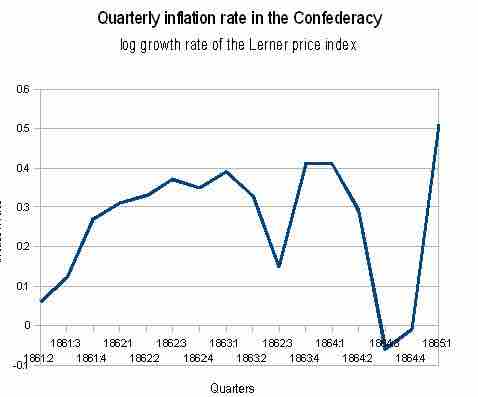An inflation premium is the part of prevailing interest rates that results from lenders compensating for expected inflation by pushing nominal interest rates to higher levels.

Inflation rate graph
Inflation rate in the Confederacy during the American Civil War.
In economics and finance, an individual who lends money for repayment at a later point in time expects to be compensated for the time value of money, or not having the use of that money while it is lent. In addition, they will want to be compensated for the risks of the money having less purchasing power when the loan is repaid. These risks are systematic risks, regulatory risks and inflationary risks. The first includes the possibility that the borrower will default or be unable to pay on the originally agreed upon terms, or that collateral backing the loan will prove to be less valuable than estimated. The second includes taxation and changes in the law which would prevent the lender from collecting on a loan or having to pay more in taxes on the amount repaid than originally estimated. The third takes into account that the money repaid may not have as much buying power from the perspective of the lender as the money originally lent, that is inflation, and may include fluctuations in the value of the currencies involved. The inflation premium will compensate for the third risk, so investors seek this premium to compensate for the erosion in the value of their capital, due to inflation.
Actual interest rates (without factoring in inflation) are viewed by economists and investors as being the nominal (stated) interest rate minus the inflation premium.
The Fisher equation in financial mathematics and economics estimates the relationship between nominal and real interest rates under inflation. In economics, this equation is used to predict nominal and real interest rate behavior. Letting r denote the real interest rate, i denote the nominal interest rate, and let π denote the inflation rate, the Fisher equation is: i = r + π. In the Fisher equation, π is the inflation premium.
For example, if an investor were able to lock in a 5% interest rate for the coming year and anticipates a 2% rise in prices, he would expect to earn a real interest rate of 3%. 2% is the inflation premium. This is not a single number, as different investors have different expectations of future inflation.
Since the inflation rate over the course of a loan is not known initially, volatility in inflation represents a risk to both the lender and the borrower.